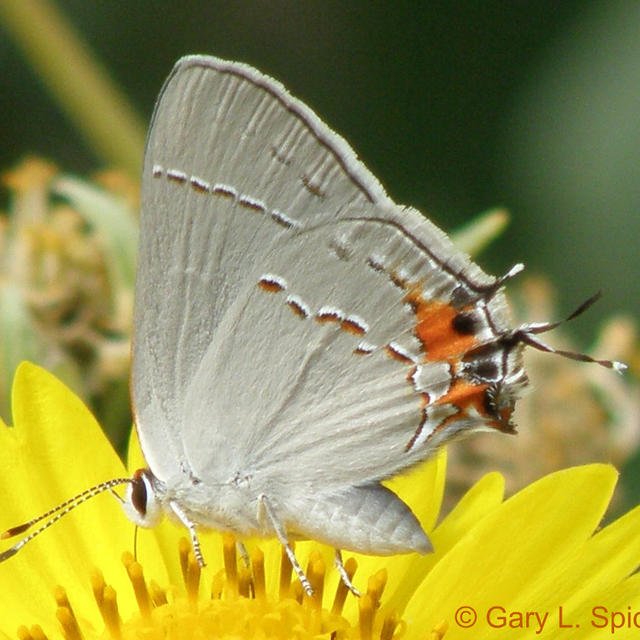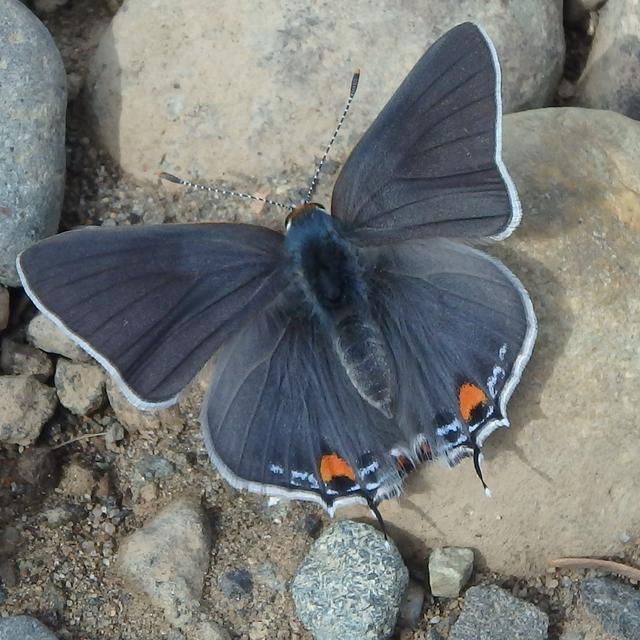Gray Hairstreak
Strymon melinus (Hübner, 1818)
Family: Lycaenidae
Subfamily: Theclinae
Identification: One tail on hindwing. Upperside blue-gray with large red spot near tail. Underside of spring/fall form is dark gray, summer form is paler gray. Relatively straight postmedian line is white, bordered with orange on the inside edge.
Wing Span: 7/8 - 1 3/8 inches (2.2 - 3.5 cm).
Life History: Males perch all afternoon on small trees and shrubs to seek receptive females. Eggs are laid singly on flowers of host plant. Young caterpillars feed on flowers and fruits; older ones may eat leaves. Chrysalids hibernate.
Flight: Two flights from May-September in the north, three-four flights from February-November in the south.
Caterpillar Hosts: Flowers and fruits from an almost endless variety of plants; most often from pea (Fabaceae) and mallow (Malvaceae) families including beans (Phaseolus), clovers (Trifolium), cotton (Gossypium), and mallow (Malva).
Adult Food: Nectar from many flower species including dogbane, milkweed, mint, winter cress, goldenrod, tick trefoil, and white sweet clover.
Habitat: Open, nonforested sites; common in disturbed, weedy areas.
Range: Throughout continental United States from southern Canada south to Mexico; southward to Venezuela. Comments: The most widespread hairstreak in North America.
Conservation: Not usually required.
NCGR: G5 - Demonstrably secure globally, though it may be quite rare in parts of its range, especially at the periphery.
Management Needs: Caterpillars may cause economic damage to bean and cotton crops.
BAMONA Shop
Please donate!
We depend on donations to keep Butterflies and Moths of North America freely available. We want to express our gratitude to all who showed their support by making a contribution this year. You can donate to support this project at any time.
Advertise with us!
Do you have a product or service that you think would interest BAMONA users? If you would like to advertise on this website, contact us by email, or use the contact form and select the "Advertising" category.
Verified Sightings
Displaying 1 - 24 of 7063 verified sightings

Observation date: Aug 18, 2025
Submitted by: tiki33wv
Region: Wood County, West Virginia, United States
Verified by: curtis.lehman
Verified date: Aug 18, 2025

Observation date: Jul 11, 2025
Submitted by: Ed Rothwell
Region: Spokane County, Washington, United States
Verified by: davidwdroppers
Verified date: Aug 14, 2025

Observation date: Aug 13, 2025
Submitted by: Bowbender
Region: Ashland County, Ohio, United States
Verified by: rogerdowner
Verified date: Aug 13, 2025

Observation date: Jul 22, 2025
Submitted by: Malor Mothspark
Region: Madison County, Kentucky, United States
Verified by: CA Ivy
Verified date: Aug 12, 2025

Observation date: Aug 11, 2025
Submitted by: jmgesell
Region: Dare County, North Carolina, United States
Verified by: Dennis Forsythe
Verified date: Aug 12, 2025

Observation date: Aug 07, 2025
Submitted by: Ozark_Bill
Region: St. Louis County, Missouri, United States
Verified by: Ozark_Bill
Verified date: Aug 08, 2025

Observation date: Aug 04, 2025
Submitted by: maryjanzen
Region: Centre County, Pennsylvania, United States
Verified by: davidwright
Verified date: Aug 06, 2025

Observation date: Aug 03, 2025
Submitted by: mrheault
Region: British Columbia, Canada
Verified by: Paul Prappas
Verified date: Aug 05, 2025

Observation date: Jul 10, 2025
Submitted by: klamke
Region: Scotts Bluff County, Nebraska, United States
Verified by: Emily Geest
Verified date: Jul 30, 2025

Observation date: Jul 25, 2025
Submitted by: mstanek
Region: Ventura County, California, United States
Verified by: Ken Davenport
Verified date: Jul 25, 2025

Observation date: Jul 25, 2025
Submitted by: mstanek
Region: Ventura County, California, United States
Verified by: Ken Davenport
Verified date: Jul 25, 2025

Observation date: Apr 17, 2024
Submitted by: beverlynantz
Region: Harlan County, Kentucky, United States
Verified by: CA Ivy
Verified date: Jul 25, 2025

Observation date: Jul 23, 2025
Submitted by: Sophia Reyes
Region: San Benito County, California, United States
Verified by: Ken Davenport
Verified date: Jul 24, 2025

Observation date: Jun 16, 2025
Submitted by: madamirie
Region: Monterey County, California, United States
Verified by: Ken Davenport
Verified date: Jul 21, 2025

Observation date: May 26, 2025
Submitted by: ncrosbyrd
Region: McIntosh County, Georgia, United States
Verified by: Mikelchap
Verified date: Jul 20, 2025

Observation date: Feb 12, 2018
Submitted by: Rob Williams
Region: Leon County, Florida, United States
Verified by: John Calhoun
Verified date: Jul 14, 2025

Observation date: Sep 27, 2024
Submitted by: Rob Williams
Region: Leon County, Florida, United States
Verified by: John Calhoun
Verified date: Jul 14, 2025

Observation date: Apr 13, 2020
Submitted by: Rob Williams
Region: Leon County, Florida, United States
Verified by: John Calhoun
Verified date: Jul 14, 2025

Observation date: Jul 11, 2025
Submitted by: Daniel Morton
Region: Somerset County, New Jersey, United States
Verified by: jwileyrains
Verified date: Jul 12, 2025

Observation date: Jul 07, 2025
Submitted by: Dennis Forsythe
Region: Berkeley County, South Carolina, United States
Verified by: Dennis Forsythe
Verified date: Jul 08, 2025

Observation date: Jul 01, 2025
Submitted by: Sophia Reyes
Region: Santa Cruz County, California, United States
Verified by: Ken Davenport
Verified date: Jul 06, 2025

Observation date: Jun 12, 2025
Submitted by: Sophia Reyes
Region: Santa Cruz County, California, United States
Verified by: Ken Davenport
Verified date: Jul 06, 2025

Observation date: Jun 22, 2025
Submitted by: Sophia Reyes
Region: Orange County, California, United States
Verified by: Ken Davenport
Verified date: Jul 06, 2025

Observation date: Jul 01, 2025
Submitted by: Eric Hartshaw
Region: Lycoming County, Pennsylvania, United States
Verified by: davidwright
Verified date: Jul 04, 2025
- 1 of 295
- next ›

















